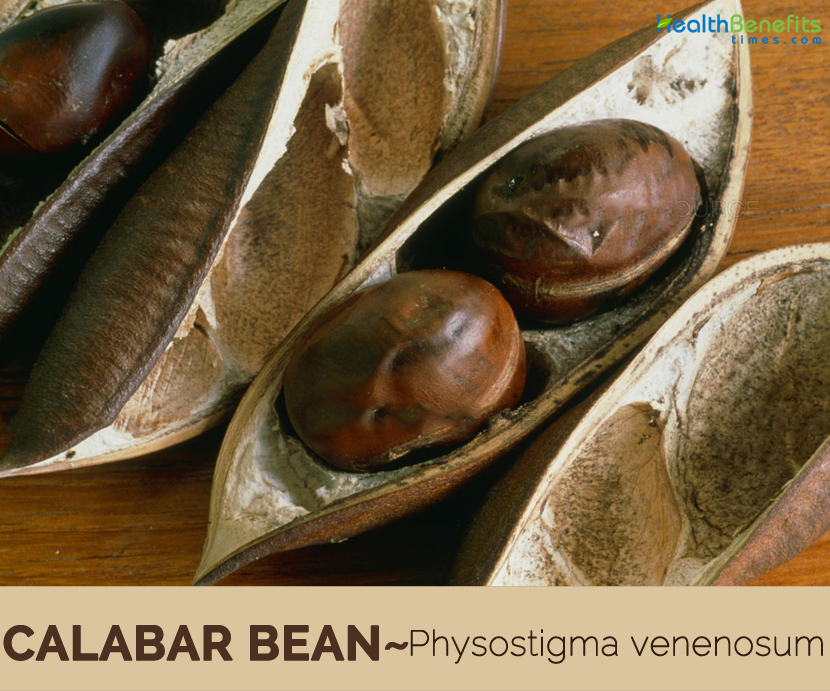| Calabar Bean Quick Facts | |
|---|---|
| Name: | Calabar Bean |
| Scientific Name: | Physostigma venenosum |
| Origin | West Africa |
| Colors | Dark brown |
| Shapes | Seed pods that grow to about 6 or 7 inches (15 or 18 cm) in length. Each pod contains from 2 to 3 seeds. |
| Health benefits | Beneficial for depressant action in anxiety, epilepsy and cholera, treat myasthenia gravis, Alzheimer's disease |
Plant Description
Calabar bean is a large, evergreen, herbaceous, scrambling or climbing perennial with the stem woody at the base, up to 2 inches (5 cm) in diameter. The plant is found growing in closed rain-forests, primary and secondary, dry and wet; riparian seasonally flooded forest and marshes. The plant has a habit like the scarlet runner, and attains a height of about 50 feet (15 m) climbing high among the trees. The plant has large, pinnate, trifoliate leaves. The flowers, resting on axillary peduncles, are large, about an inch long, grouped in pendulous, fascicled racemes pale-pink or purplish, and beautifully veined. The fruit is a dark brown pod that grows to about 6 or 7 inches (15 or 18 cm) in length. Each pod contains from 2 to 3 seeds. The dark brown or blackish kidney-shaped seeds are about 2.5 cm long and have an extremely hard shell. They are rounded at the ends, uneven and somewhat polished with the hilum extending along the whole convex side. The cotyledons are whitish.
History
This plant is native to an area of Africa around Nigeria once known as Calabar. The plant is widely known in Africa because the seeds had been used as an “ordeal poison” to determine if a person was a witch or controlled by evil spirits. When used for this purpose, the victim was made to ingest several beans; if the person vomited the beans and survived the “ordeal,” his innocence was declared. Western settlers who were captured by native tribes and who underwent the “ordeal” soon learned not to chew the bean, but to swallow the kidney-shaped bean intact, thus not permitting the release of the toxic constituents. The plant has been long recognized as a commercial source of the alkaloid physostigmine, first isolated in 1864.
Traditional uses and benefits of Calabar bean
- It is also used as a stimulant to the unstriped muscles of the intestines in chronic constipation.
- It is a narcotic herb that depresses the central nervous system, mimics the para-sympathetic nervous system, contracts the pupil of the eye, raises blood pressure and stimulates peristalsis.
- It is used in eye drops to reduce pressure on the eyeball in treating conditions such as glaucoma.
- It is also recommended for internal use in the treatment of neuromuscular diseases, especially myasthenia gravis, and for treating post-operative constipation.
- It has been used in the treatment of conditions such as tetanus, epilepsy and rheumatism.
- It has also been used as internal medications in the treatment of certain kinds of nervous complaints.
- It is used in treating retinitis accompanying problems like photophobia.
- It is used to treat photophobia accompanied by strumous ophthalmia.
- It is used to treat granular and irritable lids.
- It is used in the treatment of ulceration along the margins of the cornea.
- It is used in the treatment of prolapsus affecting the iris.
- Calabar bean is being studied as a treatment for Alzheimer’s disease.
- It is used to treat related disorder symptoms such as muscle soreness and headache.
- It is useful in tympanities and flatulence that may be present during menopause.
- It is used for its depressant action in anxiety, epilepsy and cholera.
- It is also used to treat myasthenia gravis.
- It helps in treating emphysema and in asthma with great muscular relaxation.
- It increases the contractility of the muscles of the bladder and uterus walls.
- It is use in the treatment of Alzheimer’s disease to reduce memory loss.
Usual dose for calabar bean
The dose for calabar bean may be different for every patient. The dose that you take depends on your age, health, and several other conditions. Herbs are not always safe. Please discuss with your herbalist or doctor for your appropriate dosage. Since the herb is considered toxic used very carefully and minor doses.
Precautions
- When used in excess, it causes muscular weakness, respiratory failure and cardiac arrest.
- Calabar bean can cause excess saliva and sweat, reducing the size of the pupil of the eye, nausea, vomiting, diarrhea beats irregular heart, changes in blood pressure, confusion, convulsions, coma, severe muscle weakness, paralysis, severe breathing problems and death.
- Avoid calabar bean if you are pregnant or breast-feeding.
- Avoid calabar bean if you have Parkinson’s disease.
- Avoid calabar bean if you have heart disease or slow heartbeat.
- Avoid calabar bean if you have blockage of the intestinal tract.
- Lethal doses can cause muscle twitching, spasms, tachycardia and cyanosis through asphyxiation.
References:
https://www.itis.gov/servlet/SingleRpt/SingleRpt?search_topic=TSN&search_value=506263#null
https://www.drugs.com/npp/calabar-bean.html
https://www.botanical.com/botanical/mgmh/c/calbea05.html
https://plants.usda.gov/core/profile?symbol=phve11
https://en.wikipedia.org/wiki/Physostigma_venenosum
https://sussle.org/t/Calabar_bean
Comments
comments
